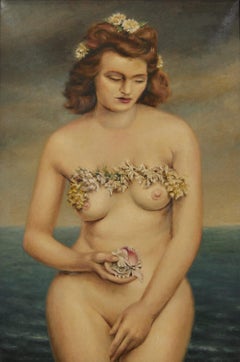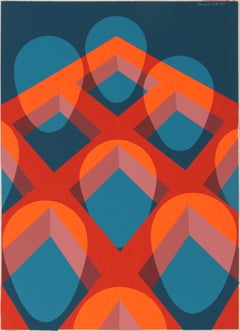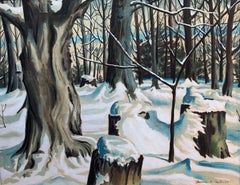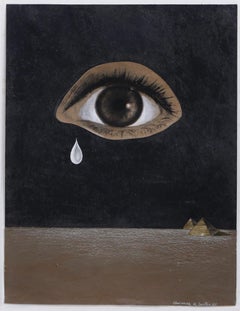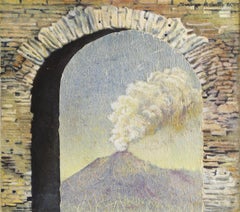Clarence Holbrook Carter Art
American, 1904-2000
Clarence Holbrook Carter achieved a level of national artistic success that was nearly unprecedented among Cleveland School artists of his day, with representation by major New York dealers, scores of awards and solo exhibits, and streams of praise flowing from pens of the top art critics. Over the course of his 60+ year career Carter evolved from an exceptionally fine American Scene painter capable of evoking deep reservoirs of mood, into an abstractionist with a strongly surrealist bent.
While his two bodies of work seem at first to be worlds apart, owing to their different formal vocabularies, they, in fact, explore virtually the same subject: the nexus between life and death and the transition from earth to spirit. The early work finds its expressive power through specific people, events, and landscapes—most of which are drawn from his experiences growing up in the river town of Portsmouth, Ohio—while the later work from the 1960s on evokes potent states of being through pure flat shape, color and form that read as universals. As his primary form he adopted the ovoid or egg shape, endowing it with varying degrees of transparency. Alone or in multiples, the egg moves through Carter’s landscapes and architectural settings like a sentient spirit on a restless quest.
Born and raised in southern Ohio along the banks of the mercurial Ohio River and its treacherous floods, Carter developed a love of drawing as a child, and was encouraged by both his parents. He was self-directed, found inspiration all around him, and was strongly encouraged by the fact that his teenage work consistently captured art prizes in county and state fairs. Carter studied at the Cleveland School of Art from 1923-27, where he trained under painters Henry Keller, Frank Wilcox and Paul Travis.
Returning to Cleveland in 1929, Carter had his first solo show, and through Milliken taught studio classes at the Cleveland Museum of Art from 1930-37. In 1938, he moved to Pittsburgh to teach at the Carnegie Institute of Technology until 1944. Carter’s American Scene paintings of the ’30s and ’40s, which launched his artistic star, are the works for which the artist remains best known.
During and immediately after World War II, Clarence Carter realized his attraction to bold pattern, dramatic perspective and eye-catching hard-edged design was a poor fit with the prevailing style of Abstract Expressionism. Fortunately, these same hallmarks of his style were prized within the realm of commercial art.
Around 1964 Carter acknowledged a need to break from the confines of representational painting. Once Carter had found a potent symbol in the egg, he used it to create an astounding body of imagery for the rest of his life. Among the most ambitious of all his later paintings were his Transections, a theological term meaning to cross, specifically between life and death.to
3
12
19
54
20
3
Overall Width
to
Overall Height
to
108
2
2
4
7
34
49
7
2
65
16
13
1
1
66
39
3
11
11
7
6
4
4
4
4
4
4
3
3
2
2
2
2
2
2
2
2
63
39
39
31
15
108
8,779
2,809
1,642
1,313
64
37
108
Artist: Clarence Holbrook Carter
Venus, Large 20th Century Painting of Nude Woman w/ Garland
By Clarence Holbrook Carter
Located in Beachwood, OH
Clarence Holbrook Carter (American, 1904-2000)
Venus, 1940
Signed Clarence H. Carter and dated 40. (ur)
Oil on canvas
40 x 27 inches
48 x 35 inches, framed
Clarence Holbrook Carter ...
Category
1940s Clarence Holbrook Carter Art
Materials
Oil
Mandalas, Surrealist Screenprint by Clarence Holbrook Carter 1973
By Clarence Holbrook Carter
Located in Long Island City, NY
Artist: Clarence Holbrook Carter, American (1904 - 2000)
Title: Untitled (Mandalas in a Grid)
Year: 1973
Medium: Screenprint on Scintilla paper, Signed and numbered in pencil
Edition...
Category
1970s Abstract Geometric Clarence Holbrook Carter Art
Materials
Screen
The Ninth Hour, Signed Screenprint by Clarence Carter
By Clarence Holbrook Carter
Located in Long Island City, NY
The Ninth Hour
Clarence Holbrook Carter
American (1904–2000)
Date: 1978
Screenprint, signed and numbered in pencil
Edition of 200, AP 30
Size: 40 in. x 26 in. (101.6 cm x 66.04 cm)
Category
1970s American Modern Clarence Holbrook Carter Art
Materials
Screen
Snow in Forest, Mid-Century Winter Landscape, Cleveland School Artist
By Clarence Holbrook Carter
Located in Beachwood, OH
Clarence Holbrook Carter (American, 1904-2000)
Snow in the Forest, 1945
Watercolor on paper
Signed and dated lower right
19 x 23.75 inches
24 x 29 inches, framed
Clarence Holbrook C...
Category
1940s American Modern Clarence Holbrook Carter Art
Materials
Watercolor
Eye of the Desert, Figural Abstract collage, Surrealist Black & Brown painting
By Clarence Holbrook Carter
Located in Beachwood, OH
Clarence Holbrook Carter (American, 1904-2000)
Eye of the Desert, 1965
Collage, graphite and gouache on paper
Signed and dated lower right
16 x 12 inches
25 x 21 inches, framed
A mid-century figural abstract painting.
Clarence Holbrook Carter achieved a level of national artistic success that was nearly unprecedented among Cleveland School artists of his day, with representation by major New York dealers...
Category
1960s American Modern Clarence Holbrook Carter Art
Materials
Gouache, Graphite
Volcano and Arch, Taormina, Sicily, Italy, Mid Century Cleveland School Artist
By Clarence Holbrook Carter
Located in Beachwood, OH
Clarence Holbrook Carter (American, 1904-2000)
Volcano and Arch, Taormina, 1961
Watercolor on scintilla paper
Signed and dated upper right
11 x 11 inches
"My last year in art schoo...
Category
1960s American Modern Clarence Holbrook Carter Art
Materials
Watercolor
Torre di Tiberio, Tower of Tiberius, Capri, Italy Landscape, Cleveland School
By Clarence Holbrook Carter
Located in Beachwood, OH
Clarence Holbrook Carter (American, 1904-2000)
Torre di Tiberio, 1951
Oil on canvas
Signed and dated lower left
21 x 18 inches
28.5 x 26.5 inches, framed
Clarence Holbrook Carter ac...
Category
1950s American Modern Clarence Holbrook Carter Art
Materials
Oil
Dichotomy, mid-century figural abstract green oil painting
By Clarence Holbrook Carter
Located in Beachwood, OH
Clarence Holbrook Carter (American, 1904-2000)
Dichotomy, 1962
Oil on paper
Signed and dated upper left
20 x 25 inches
Mid-century figural abstract green painting of woman swimming ...
Category
1960s American Modern Clarence Holbrook Carter Art
Materials
Oil
Highway, Pop Art Screenprint by Clarence Holbrook Carter
By Clarence Holbrook Carter
Located in Long Island City, NY
Artist: Clarence Holbrook Carter, American (1904 - 2000)
Title: Highway
Year: 1979
Medium: Screenprint, signed and numbered in pencil
Edition: 200
Image Size: 30 x 22 inches
Paper Si...
Category
1970s Op Art Clarence Holbrook Carter Art
Materials
Screen
The Mayor, Mid-Century Ovoid Figural Abstract Acrylic & Collage with Eye
By Clarence Holbrook Carter
Located in Beachwood, OH
Clarence Holbrook Carter (American, 1904-2000)
The Mayor, 1979
Acrylic and collage on scintilla
Signed lower right
30 x 22 inches
A surrealist mid-century figural abstract painting....
Category
1970s American Modern Clarence Holbrook Carter Art
Materials
Acrylic
King Tut No. 2, Mid-Century Ovoid Geometrical Abstract Gouache on Paper
By Clarence Holbrook Carter
Located in Beachwood, OH
Clarence Holbrook Carter (American, 1904-2000)
King Tut No. 2, 1968
Gouache on paper
Signed and dated upper right
11.25 x 8.25 inches
25.5 x 20.5 inches
A surrealist mid-century fig...
Category
1960s American Modern Clarence Holbrook Carter Art
Materials
Gouache
Over and Above Surprise (Serpent), 1960s snake painting, Cleveland School
By Clarence Holbrook Carter
Located in Beachwood, OH
Clarence Holbrook Carter (American, 1904-2000)
Over and Above Surprise (Serpent), 1967
Casein on board
Signed lower right
7.75 x 5.5 inches
Clarence Holbrook Carter achieved a lev...
Category
1960s American Modern Clarence Holbrook Carter Art
Materials
Casein
Bauxite Factory, Suriname, Signed Lithograph by Clarence Carter
By Clarence Holbrook Carter
Located in Long Island City, NY
Bauxite Factory, Suriname
Clarence Holbrook Carter
American (1904–2000)
Date: 1980
Lithograph, signed and numbered in pencil
Edition of 200, AP 30
Image Size: 17.75 x 26 inches
Siz...
Category
1980s American Modern Clarence Holbrook Carter Art
Materials
Lithograph
Night Garden, mid-century figural surrealist acrylic painting, Cleveland School
By Clarence Holbrook Carter
Located in Beachwood, OH
Clarence Holbrook Carter (American, 1904-2000)
Night Garden, 1972
Acrylic on scintilla
Signed and dated lower right
21.5 x 21.5 inches
24.25 x 24.25 inches, framed
Clarence Holbroo...
Category
1970s American Modern Clarence Holbrook Carter Art
Materials
Acrylic
"People" - Mid-Century Ovoid Geometrical Abstract Black & White Drawing
By Clarence Holbrook Carter
Located in Beachwood, OH
Clarence Holbrook Carter (American, 1904-2000)
People, 1964
Ink and crayon on paper
Signed and dated upper right
36.5 x 24 inches
Clarence Holbrook Carter achieved a level of nation...
Category
1960s American Modern Clarence Holbrook Carter Art
Materials
Crayon, Ink
Chimeras, mid-century figural abstract blue acrylic painting
By Clarence Holbrook Carter
Located in Beachwood, OH
Chimeras, 1974
Acrylic and pastel on textured paper
Mid-century figural abstract blue acrylic painting
Clarence Holbrook Carter achieved a level of national artistic success that w...
Category
1970s American Modern Clarence Holbrook Carter Art
Materials
Pastel, Acrylic
Chromatic, Ovoid Head, Geometric Figurative Abstract Acrylic & Collage Painting
By Clarence Holbrook Carter
Located in Beachwood, OH
Clarence Holbrook Carter (American, 1904-2000)
Chromatic, 1965
Acrylic and collage on scintilla
Signed and dated upper right
30 x 22 inches
A surrealist mid-century figural abstrac...
Category
1960s American Modern Clarence Holbrook Carter Art
Materials
Acrylic
Hospitalities Long Past, 1940s Oil Painting of Store Front
By Clarence Holbrook Carter
Located in Beachwood, OH
Clarence Holbrook Carter (American, 1904-2000)
Hospitalities Long Past, 1941
Oil on canvas
Signed and dated lower right
37 x 27 inches
"Looking into store front windows has always i...
Category
1940s American Modern Clarence Holbrook Carter Art
Materials
Oil
Seeing Egg No. 2, Surrealist Ovoid acrylic painting, Figural Abstract
By Clarence Holbrook Carter
Located in Beachwood, OH
Clarence Holbrook Carter (American, 1904-2000)
Seeing Egg No. 2, 1965
Acrylic and collage on scintilla
Signed and dated upper right
30 x 22 inches
34 x 29 inches, framed
A surrealis...
Category
1960s American Modern Clarence Holbrook Carter Art
Materials
Acrylic
Quadratic, Mid-Century Ovoid Figural Abstract Acrylic & Collage with faces
By Clarence Holbrook Carter
Located in Beachwood, OH
Clarence Holbrook Carter (American, 1904-2000)
Quadratic, 1979
Acrylic and collage on textured paper
Signed and dated lower right
30 x 22 inches
31.5 x 23.5 inches, framed
A surreal...
Category
1970s American Modern Clarence Holbrook Carter Art
Materials
Acrylic
Caged, Mid-Century Ovoid Geometrical Abstract Acrylic, Black & Grey
By Clarence Holbrook Carter
Located in Beachwood, OH
Clarence Holbrook Carter (American, 1904-2000)
Caged, 1971
Acrylic on paper
Signed and dated lower right
24 x 20 inches
A surrealist mid-century figural abstract painting.
Clarenc...
Category
1970s American Modern Clarence Holbrook Carter Art
Materials
Acrylic
Up the Avenue, Geometrical Ovoid Abstract Acrylic & Collage Cityscape
By Clarence Holbrook Carter
Located in Beachwood, OH
Clarence Holbrook Carter (American, 1904-2000)
Up the Avenue, 1979
Acrylic and collage on paper
Signed and dated lower right
15 x 11 inches
A surrealist mid-century figural abstract...
Category
1970s American Modern Clarence Holbrook Carter Art
Materials
Mixed Media, Acrylic
The Way Out, figural abstract vibrant orange geometric acrylic painting
By Clarence Holbrook Carter
Located in Beachwood, OH
Clarence Holbrook Carter (American, 1904-2000)
The Way Out, 1992
Acrylic on paper
Signed and dated upper right
24 x 30 inches
Figural abstract vibrant orange geometric painting.
C...
Category
1990s Abstract Clarence Holbrook Carter Art
Materials
Acrylic
"Rockefeller Center" - Abstract Rock, Mid-Century Acrylic & Sand Painting
By Clarence Holbrook Carter
Located in Beachwood, OH
Clarence Holbrook Carter (American, 1904-2000)
Rockefeller Center, 1962
Acrylic and sand on scintilla
Signed and dated lower left
25 x 20 inches
Clarence Holbrook Carter achieved a ...
Category
1960s American Modern Clarence Holbrook Carter Art
Materials
Mixed Media, Acrylic
Neon Ovoids, Mid-Century Abstract neon orange, green, pink acrylic painting
By Clarence Holbrook Carter
Located in Beachwood, OH
Clarence Holbrook Carter (American, 1904-2000)
Neon Ovoids, c. 1960s
Acrylic on paper
9 x 12 inches
Mid-Century Abstract neon orange, green, pink acrylic painting.
Clarence Holbroo...
Category
1960s Surrealist Clarence Holbrook Carter Art
Materials
Acrylic
Icon Mandala, Mid-Century Figural Abstract Black, Red & White Oval Face Painting
By Clarence Holbrook Carter
Located in Beachwood, OH
Clarence Holbrook Carter (American, 1904-2000)
Icon Mandala, 1967
Acrylic on paper
Signed and dated lower right
30 x 22 inches
Clarence Holbrook Carter achieved a level of national ...
Category
1960s Abstract Clarence Holbrook Carter Art
Materials
Acrylic
Medieval Heads, mid-century figural surrealist acrylic painting
By Clarence Holbrook Carter
Located in Beachwood, OH
Clarence Holbrook Carter (American, 1904-2000)
Cicada, c. 1960s
Watercolor on scintilla
30 x 20 inches
Clarence Holbrook Carter achieved a level of national artistic success that wa...
Category
1960s American Modern Clarence Holbrook Carter Art
Materials
Acrylic
Reverberations, mid-century abstract surrealist black acrylic painting
By Clarence Holbrook Carter
Located in Beachwood, OH
Clarence Holbrook Carter (American, 1904-2000)
Reverberations, 1970
Acrylic on illustration board
Signed lower left
20 x 30 inches
Mid-century abstract surrealist black acrylic painting...
Category
1970s Surrealist Clarence Holbrook Carter Art
Materials
Acrylic
Eschatos #23, Surrealist Landscape Screenprint by Clarence Holbrook Carter
By Clarence Holbrook Carter
Located in Long Island City, NY
The sublime, or the amalgamation of the terrifying and the awe-inspiring, is encapsulated by the crashing wave that dominates this surrealist landscape.
Artist: Clarence Holbrook Ca...
Category
1970s Surrealist Clarence Holbrook Carter Art
Materials
Screen
Pilgrimage #4, Screenprint by Clarence Holbrook Carter
By Clarence Holbrook Carter
Located in Long Island City, NY
Artist: Clarence Holbrook Carter, American (1904 - 2000)
Title: Pilgrimage #4
Year: 1977
Medium: Serigraph, signed and numbered in pencil
Edition: 200, 30 AP
Size: 26 in. x 34 in. (6...
Category
1970s Surrealist Clarence Holbrook Carter Art
Materials
Screen
Pilgrimage #6, Surrealist Screenprint by Clarence Holbrook Carter
By Clarence Holbrook Carter
Located in Long Island City, NY
Artist: Clarence Holbrook Carter, American (1904 - 2000)
Title: Pilgrimage #6
Year: 1977
Medium: Screenprint, signed and numbered in pencil
Edition: 200, 30 AP
Size: 26 in. x 34 in. ...
Category
1970s Surrealist Clarence Holbrook Carter Art
Materials
Screen
Brown Mandala, Silkscreen by Clarence Holbrook Carter
By Clarence Holbrook Carter
Located in Long Island City, NY
Artist: Clarence Holbrook Carter, American (1904 - 2000)
Title: Brown Mandala
Year: 1969
Medium: Silkscreen on Scintilla paper, signed and numbered in pencil
Edition: 75
Paper Size: ...
Category
1960s Op Art Clarence Holbrook Carter Art
Materials
Screen
Burning Bush, Screenprint by Clarence Holbrook Carter
By Clarence Holbrook Carter
Located in Long Island City, NY
Artist: Clarence Holbrook Carter, American (1904 - 2000)
Title: Burning Bush
Year: 1978
Medium: Silkscreen, signed and numbered in pencil
Edition: 200, AP...
Category
1970s Surrealist Clarence Holbrook Carter Art
Materials
Screen
Study for Worlds Beyond - Surrealist graphite drawing, Ohio artist
By Clarence Holbrook Carter
Located in Beachwood, OH
Clarence Holbrook Carter (American, 1904-2000)
Study for Worlds Beyond, 1980
Graphite, collage and white heightening on illustration board
Signed and dated lower right
10.75 x 4.5 in...
Category
1980s American Modern Clarence Holbrook Carter Art
Materials
Graphite
Green Mandala, Geometric Minimalist Screenprint by Clarence Holbrook Carter
By Clarence Holbrook Carter
Located in Long Island City, NY
Artist: Clarence Holbrook Carter, American (1904 - 2000)
Title: Green Mandala
Year: 1969
Medium: Screenprint on Scintilla paper, signed and numbered in pencil
Edition: 75
Paper Size:...
Category
1970s Abstract Clarence Holbrook Carter Art
Materials
Screen
Red Mandala, OP Art Geometric Abstract Screenprint by Clarence Holbrook Carter
By Clarence Holbrook Carter
Located in Long Island City, NY
Artist: Clarence Holbrook Carter, American (1904 - 2000)
Title: Red Mandala
Year: 1969
Medium: Screenprint on Japon, Signed and numbered in pencil
Edition: 75
Paper Size: 30 in. x 22...
Category
1960s Op Art Clarence Holbrook Carter Art
Materials
Screen
Oil Well, Modern American Painting by Clarence Carter
By Clarence Holbrook Carter
Located in Long Island City, NY
An acrylic painting by Clarence Holbrook Carter from 1979. Carter's modernist style utilizes strong structural lines and architectural aesthetics to form almost surreal-like scenes. Signed on lower right corner, framed in elegant silver wooden frame.
Artist: Clarence Holbrook Carter, American (1904 - 1998)
Title: Oil Well...
Category
1970s Modern Clarence Holbrook Carter Art
Materials
Paper, Acrylic
Transection No. 7, Large Painting by Clarence Carter
By Clarence Holbrook Carter
Located in Long Island City, NY
Artist: Clarence Holbrook Carter, American (1904 - 1998)
Title: Transection No. 7
Year: 1970
Medium: Acrylic on Canvas, signed verso
Size: 77 in. x 75.5 in. (195.58 cm x 191.77 c...
Category
1970s Abstract Geometric Clarence Holbrook Carter Art
Materials
Oil
OLIVE TREES, CAPRI
By Clarence Holbrook Carter
Located in Portland, ME
Carter, Clarence Holbrook (American, 1904-2000). OLIVE TREES, CAPRI. Aquatint in colors, 1932. Titled,signed and dated in pencil. 5 1/2 x 6 7/8 inches (plat...
Category
1930s Clarence Holbrook Carter Art
Materials
Aquatint
Maidenhood, Signed Lithograph by Clarence Carter
By Clarence Holbrook Carter
Located in Long Island City, NY
Maidenhood
Clarence Holbrook Carter
American (1904–2000)
Date: 1977
Lithograph, signed and numbered in pencil
Edition of 200, AP 30
Image Size: 27 x 19.5 inches
Size: 30 in. x 22 i...
Category
1970s American Modern Clarence Holbrook Carter Art
Materials
Lithograph
Sleeping Cat, Early 20th Century, Cleveland School Artist
By Clarence Holbrook Carter
Located in Beachwood, OH
Clarence Holbrook Carter (American, 1904-2000)
Sleeping Cat, 1929
Watercolor on paper
Signed and dated upper right
15 x 19 inches
21.25 x 25.25 inches, framed
Clarence Holbrook Car...
Category
1920s American Modern Clarence Holbrook Carter Art
Materials
Watercolor
Over and Above: No. 6, Surreal Cat w/ Fish Bones, 20th Century Cleveland School
By Clarence Holbrook Carter
Located in Beachwood, OH
Clarence Holbrook Carter (American, 1904–2000)
Over and Above: No. 6, 1963
Oil, sand & fish bones on canvas
Signed and dated upper left
53 x 31 inches
Clarence Holbrook Carter achie...
Category
1960s American Modern Clarence Holbrook Carter Art
Materials
Oil
Yellow Calla Lily
By Clarence Holbrook Carter
Located in New York, NY
In his long and productive career, Clarence Holbrook Carter followed an independent course. He incorporated an unlikely mixture of stylistic influences, drawing from such disparate s...
Category
Early 20th Century American Realist Clarence Holbrook Carter Art
Materials
Canvas, Oil
Country Road, Signed Lithograph by Clarence Carter
By Clarence Holbrook Carter
Located in Long Island City, NY
Country Road
Clarence Holbrook Carter
American (1904–2000)
Date: Circa 1979
Lithograph, signed and numbered in pencil
Edition of 200, AP
Image Size: 24 x 18 inches
Size: 30 x 22 in...
Category
1970s American Modern Clarence Holbrook Carter Art
Materials
Lithograph
Entr'acte - Mid-Century Ovoids in Theatre - Geometrical Abstract Pastel
By Clarence Holbrook Carter
Located in Beachwood, OH
Clarence Holbrook Carter (American, 1904-2000)
Entr'acte, 1977
Pastel on board
Signed and dated lower right
8 x 10 inches
A surrealist mid-century figural abstract painting.
Clare...
Category
1970s American Modern Clarence Holbrook Carter Art
Materials
Pastel
Balancing Act, Surrealist Screenprint by Clarence Holbrook Carter
By Clarence Holbrook Carter
Located in Long Island City, NY
Artist: Clarence Holbrook Carter, American (1904 - 2000)
Title: Balancing Act
Year: 1976
Medium: Serigraph, signed and numbered in pencil
Edition: 200, A...
Category
1970s Surrealist Clarence Holbrook Carter Art
Materials
Screen
Down by the River, Signed Lithograph by Clarence Carter
By Clarence Holbrook Carter
Located in Long Island City, NY
Down by the River
Clarence Holbrook Carter
American (1904–2000)
Date: 1981
Lithograph, signed, numbered, and dated in pencil
Edition of AP 30
Size: 25 x 32 in. (63.5 x 81.28 cm)
Category
1980s American Modern Clarence Holbrook Carter Art
Materials
Lithograph
Still Life with Apples and Skull, Figurative Oil Painting by Ohio Artist
By Clarence Holbrook Carter
Located in Beachwood, OH
Clarence Holbrook Carter (American, 1904-2000)
Still Life with Apples, 1940
Oil on canvas
Signed and dated upper right
18 x 24 inches
Clarence Holbrook Carter achieved a level of national artistic success that was nearly unprecedented among Cleveland School artists of his day, with representation by major New York dealers...
Category
1940s American Modern Clarence Holbrook Carter Art
Materials
Oil
Transection No. 3, Ovoid Geometrical Figural Abstract Neon Acrylic Painting
By Clarence Holbrook Carter
Located in Beachwood, OH
Clarence Holbrook Carter (American, 1904-2000)
Transection No. 3, 1972
Acrylic on paper
Signed and dated upper right
30 x 22 inches
Provenance: Collection of William H. Milliken
Cl...
Category
1970s American Modern Clarence Holbrook Carter Art
Materials
Acrylic
Cicada, Mid-century Figural Surrealist Cleveland School Painting, 1960s
By Clarence Holbrook Carter
Located in Beachwood, OH
Clarence Holbrook Carter (American, 1904-2000)
Medieval Heads, 1966
Acrylic on scintilla
Signed and dated upper right
23.5 x 30 inches
Clarence Holbrook...
Category
1960s American Modern Clarence Holbrook Carter Art
Materials
Watercolor
City Scape, Ovoid Geometrical Abstract Green & Brown Structures
By Clarence Holbrook Carter
Located in Beachwood, OH
Clarence Holbrook Carter (American, 1904-2000)
City Scape, 1978
Acrylic on scintilla
Signed and dated lower right
30 x 22 inches
A surrealist mid-century figural abstract painting....
Category
1970s American Modern Clarence Holbrook Carter Art
Materials
Acrylic
Transection w/ Architectural Forms, Geometrical Figurative Abstract Acrylic
By Clarence Holbrook Carter
Located in Beachwood, OH
Clarence Holbrook Carter (American, 1904-2000)
Transection with Architectural Forms, c. 1980s
Acrylic and graphite on board
12 x 20 inches
A surrealist mid-century figural abstract ...
Category
1980s American Modern Clarence Holbrook Carter Art
Materials
Acrylic, Graphite
Early Spring Landscape, Signed Lithograph by Clarence Carter
By Clarence Holbrook Carter
Located in Long Island City, NY
Early Spring Landscape
Clarence Holbrook Carter
American (1904–2000)
Date: 1979
Lithograph, signed and numbered in pencil
Edition of AP 30
Image Size: 18 x 25 inches
Size: 21 x 29 ...
Category
1970s American Modern Clarence Holbrook Carter Art
Materials
Lithograph
Mandala No. 15, Abstract Ovoid Geometrical Mid-Century Painting Cleveland School
By Clarence Holbrook Carter
Located in Beachwood, OH
Clarence Holbrook Carter (American, 1904-2000)
Mandala No. 15, 1969
Acrylic on paper
Signed and dated verso
27.5 x 22 inches
Clarence Holbrook Carter achieved a level of national ar...
Category
1960s American Modern Clarence Holbrook Carter Art
Materials
Acrylic
The Gold Coast, Mid-Century Pastel Pink & Green Painting of Ovoid, Miami
By Clarence Holbrook Carter
Located in Beachwood, OH
Clarence Holbrook Carter (American, 1904-2000)
The Gold Coast, 1979
Collage and acrylic on scintilla
Signed and dated lower right
22 x 30 inches
Clarence Holbrook Carter achieved a...
Category
1970s American Modern Clarence Holbrook Carter Art
Materials
Acrylic
Expanding Mandala, Black and Orange Abstract Oval Mid-Century Painting
By Clarence Holbrook Carter
Located in Beachwood, OH
Clarence Holbrook Carter (American, 1904-2000)
Expanding Mandala, c. 1970s
Acrylic on scintilla
23 x 30 inches
Clarence Holbrook Carter achieved a level of national artistic success...
Category
1970s Abstract Clarence Holbrook Carter Art
Materials
Acrylic
Double Ovoids, Mid-Century Blue & Black Figurative Abstract Ovoids
By Clarence Holbrook Carter
Located in Beachwood, OH
Clarence Holbrook Carter (American, 1904-2000)
Double Ovoids with Blue and Black, 1960s
Acrylic on scintilla
15.25 x 12.25 inches
A surrealist mid-century figural abstract painting....
Category
1960s American Modern Clarence Holbrook Carter Art
Materials
Acrylic
Vetriculus, Surrealist Ovoid acrylic painting, Figural Abstract work on paper
By Clarence Holbrook Carter
Located in Beachwood, OH
Clarence Holbrook Carter (American, 1904-2000)
Vetriculus, c. 1970s
Acrylic on paper
4.5 x 3.5 inches
11 x 10 inches, framed
A surrealist mid-century figural abstract painting.
Cl...
Category
1970s American Modern Clarence Holbrook Carter Art
Materials
Acrylic
Seeing Egg, Surrealist Ovoid acrylic painting, Figural Abstract
By Clarence Holbrook Carter
Located in Beachwood, OH
Clarence Holbrook Carter (American, 1904-2000)
Seeing Egg, c. 1960s
Acrylic on textured paper
30 x 22 inches
38.5 x 30.5 inches, framed
A surrealist mid-century figural abstract pai...
Category
1960s American Modern Clarence Holbrook Carter Art
Materials
Acrylic
Torso No. 1, Mid-Century Figural Abstract Acrylic Painting
By Clarence Holbrook Carter
Located in Beachwood, OH
Clarence Holbrook Carter (American, 1904-2000)
Torso No. 1, 1967
Acrylic on paper
Signed and dated upper right
15 x10 inches
24 x 20 inches, framed
A mid-century figural abstract painting.
Clarence Holbrook Carter achieved a level of national artistic success that was nearly unprecedented among Cleveland School artists of his day, with representation by major New York dealers...
Category
1960s American Modern Clarence Holbrook Carter Art
Materials
Acrylic
Clarence Holbrook Carter art for sale on 1stDibs.
Find a wide variety of authentic Clarence Holbrook Carter available for sale on 1stDibs. If you’re browsing the collection of art to introduce a pop of color in a neutral corner of your living room or bedroom, you can find work that includes elements of blue, red, orange and other colors. You can also browse by medium to find art by Clarence Holbrook Carter in paint, acrylic paint, synthetic resin paint and more. Much of the original work by this artist or collective was created during the 20th century and is mostly associated with the modern style. Not every interior allows for large Clarence Holbrook Carter, so small editions measuring 8 inches across are available. Customers who are interested in this artist might also find the work of Louisa Chase, Will Barnet, and John Taylor Arms. Clarence Holbrook Carter prices can differ depending upon medium, time period and other attributes. On 1stDibs, the price for these items starts at $500 and tops out at $65,000, while the average work can sell for $8,500.
Artists Similar to Clarence Holbrook Carter
Recently Viewed
View AllMore Clarence Holbrook Carter Art
Clarence Holbrook Carter Figurative Paintings
Clarence Holbrook Carter Abstract Paintings
Clarence Holbrook Carter Abstract Prints
Clarence Holbrook Carter Landscape Prints
Clarence Holbrook Carter Landscape Paintings
Clarence Holbrook Carter Figurative Drawings and Watercolors
Clarence Holbrook Carter Animal Paintings
Clarence Holbrook Carter Figurative Prints
Clarence Holbrook Carter Abstract Drawings and Watercolors
Clarence Holbrook Carter Landscape Drawings and Watercolors
Clarence Holbrook Carter Still-life Paintings
Clarence Holbrook Carter Animal Drawings and Watercolors
